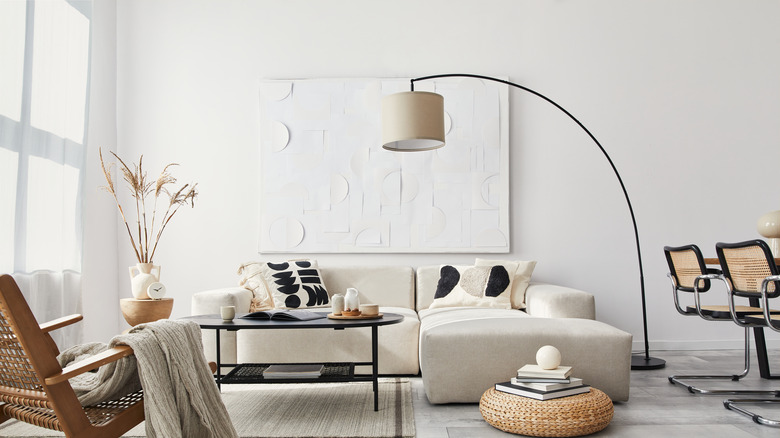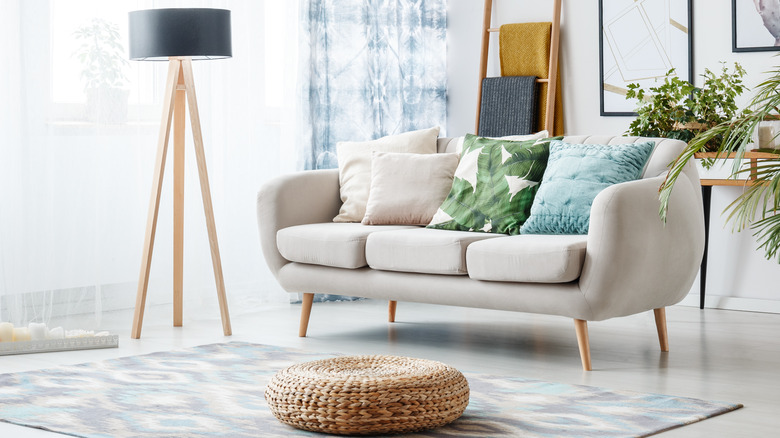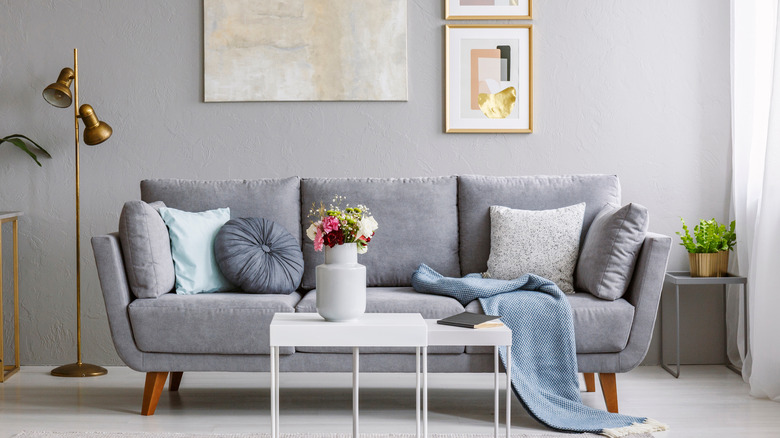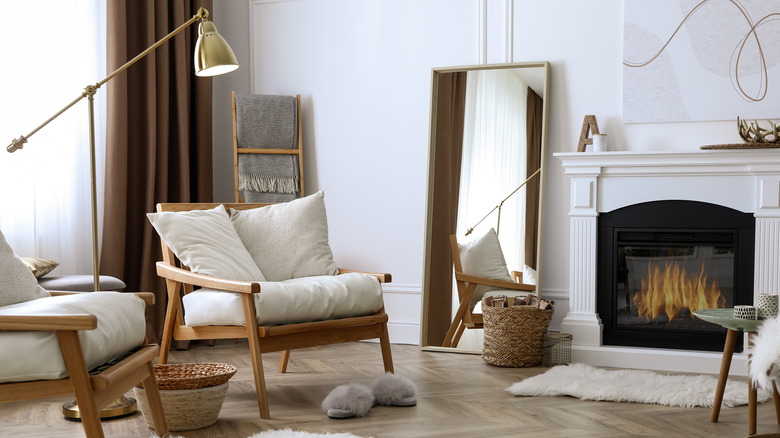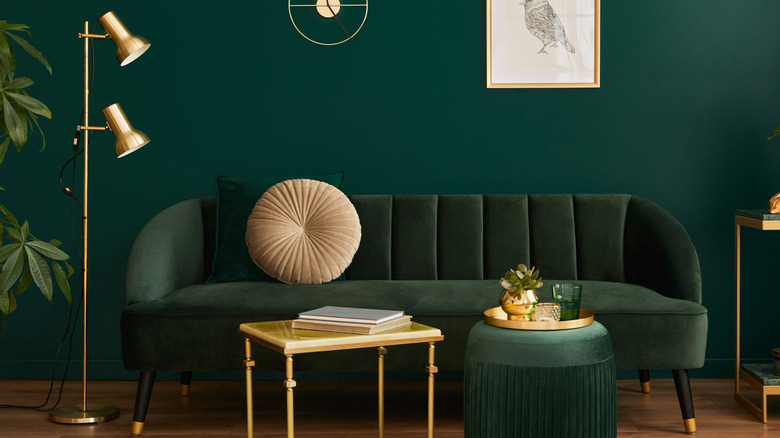How To Choose The Perfect Floor Lamp For Your Space
Having a bright and inviting home is important, not just for aesthetic and visual purposes but also for your health. According to OCLI Vision, adequate lighting in your home can help prevent eye strain, as well as improve your ability to read and discern colors. Similarly, being able to control that lighting, especially in areas of your home dedicated to rest, is essential. For example, your bedroom should have the ability to be both completely dark as well as have enough lighting to read at night for optimal sleep, per the University of Michigan.
This is where lamps come into place. The light that comes from overhead or ceiling lamps can be glaring and straining to the eyes and too bright before bed for adequate sleep. On the flip side, not every room has overhead lighting in the first place, which in turn makes the room darker. Whether you want to make your lighting more ambient and soft, or brighten a previously dark space, choosing the right floor lamp can help you achieve your goal.
Determine the lamp's purpose
Before you rush to the nearest furniture store to pick up a standing lamp, you should figure out what you need it for and its primary purpose. For example, a lamp designed for decorative purposes will differ slightly from a lamp created for functionality. You may want a standing lamp to brighten up one dark corner or the entire room.
Quill notes that each type of lamp offers different intensity levels, ambiance, direct lighting, etc. One trendy type of standing lamp is the tripod style, which is a light set atop a three-legged base. This lamp option is ideal for someone looking to illuminate an entire room. On the flip side, candelabra-style standing lamps are gorgeous but only cast a small amount of ambient lighting near where it stands. Something like a column or tower lamp, though, offers both stylistic flare and lots of light. There are plenty of options, each with its own aesthetic and practical values, but which one you choose should be determined by your individual needs.
Choose a bulb temperature
Once you've found the style of lamp you want, you need to consider what kind of light you want it to cast. More specifically, what light temperature do you want to emanate from the lamp? This is almost just as important as choosing the purpose of the lamp. Light bulb temperatures can range from very warm, yellow-toned light to very cool, blue-toned light, and each end of the spectrum has its purpose.
As The Lightbulb Company points out, having an incorrect temperature bulb can throw a room off. Warm lighting is ideal for creating a soft ambiance, but it can make reading and focus harder. On the flip side, cool lighting is excellent for keeping you awake and productive, but it can inhibit rest. Use warmer bulbs for bedrooms, dining rooms, and living rooms. For offices, kitchens, and other productive areas, use cooler bulbs for your standing lamps.
Identify an aesthetic
Aside from functionality, it would help if you also considered the aesthetic of the room you're adding the standing lamp. Maybe you've identified the need for ambient lighting in your living room and have decided on a warmer bulb and lamp that emits softer lighting. Still, you want to ensure the light meshes with the rest of the room. Conversely, just because you want a lamp for functional purposes doesn't mean it shouldn't match the surrounding furniture.
Each style of lamp (tripod, tower, torchiere, etc.) can be designed in multiple ways, one lamp lending itself to a modern style while another is more eclectic. Some lamps are inherently more grandiose than others, though. For example, Inspire Uplift points out the inherent elegance and drama an arc floor lamp adds to a room. A lamp for contemporary aesthetics would likely be slim, functional, quite geometric, and have a metallic finish, via Bassett Furniture. On the other hand, those with a taste for eclectic or maximalist décor may want a large statement floor lamp with a unique shape, contrasting color, patterned lampshade, etc., per Vevano Home.
Proper placement
Another important part of choosing a floor lamp is to make sure you get one that fits your space or to make appropriate room for it. While you only have to fit table lamps to the size of the surface they sit on, floor lamps need to blend in with the whole room seamlessly. Some easily squeeze into small corners, while others require much more space.
For example, arc lamps take up a lot of space in a room in terms of both the base and the large arc and bulb. As Build with Ferguson points out, you also need to place it in a corner, as they tend to be top heavy and can easily tip over. Putting them in an ample corner helps ensure both visual cohesivity and safety. Tripod lamps also tend to need a lot of areas, as the three legs take up a lot of room. Traditional reading, and torchiere lamps, though, tend only to need a little bit of space.
Types of floor lamps
Now that you know all the different factors that go into deciding which one is right for you, you can choose from the wide variety of available floor lamps. The arc lamp has been extensively covered throughout and is just what they sound like — a floor lamp with a large, usually dramatic arch in the pole, via Lamps USA. They lend themselves best to modern and retro designs and provide concentrated light where the bulb sits, and they are best for ambient lighting.
Almost opposite to an arc lamp is a torchiere lamp. These are pretty thin, upright lamps with a smaller shade at the top, usually directing the light straight upwards. Tiffany lamps are a trendy style of torchiere lamp. These are great to add a little bit of practical or ambient lighting in a small space. For those needing lots of light in multiple directions, consider an octopus lamp, which has many, usually bendable bulbs at the top, each of which can be pointed in a different direction. Reading lamps are similar to the concept of an arc lamp, except that they are designed with a hinge for moving the light up and down. They are more practical by nature but still decorative.

